Glareolidae is a family of birds in the wader suborder Charadri. It contains two distinct groups, the pratincoles and the coursers.
The feature that defines the family from the rest of the order is the bill, which is arched and has the nostrils at the base. The pratincoles have short legs, long pointed wings and long forked tails. They have a buoyant flight that allows them the unusual (for the order) hunting technique of taking their insect prey on the wing like swallows. The wings also allow for long migrations in some species. The coursers have long legs, which are used to run (giving the group its name. The wings are shorter and have a more sustained flight than that of the pratincoles.
The pratincoles and coursers have an Old World distribution, occurring in southern Europe, Asia, Africa and Australia. The coursers inhabit are typically found in open and arid environments such as deserts and scrub. The Three-banded Courser and Bronze-winged Courser are exceptions, being found in woodland and usually away from open land. The subfamily is usually also associated with lowland areas, although the Burchell's Courser is found in southern Africa's Afro-alpine areas. The pratincoles are associated with wetlands, rivers, estuaries and other inland waterways.
Some species of pratincole are long-distance migrants. The Black-winged Pratincole migrates from the steppes of Eastern Europe and Central Asia to West and Southern Africa. The migration, which can measure 10,000 km in distance, is often undertaken as a single non-stop flight and is flown at high altitude.The coursers are fairly nomadic, but do not undertake long distance
Insects form the majority of the diet of the Glareolidae. The pratincoles forage mainly on the wing, but are able to take prey on the ground as well.
Africa Wild Bird Book
Family Glareolidae (Coursers, Pratincoles) Index
Species indigenous to southern Africa:
Family Glareolidae (Coursers, Pratincoles)
Cursorius rufus Burchell's Courser 299
Cursorius temminckii Temminck's Courser 300
Rhinoptilus africanus Double-banded Courser 301
Rhinoptilus cinctus Three-banded Courser 302
Rhinoptilus chalcopterus Bronze-winged Courser 303
Glareola pratincola Collared Pratincole 304
Glareola nordmanni Black-winged Pratincole 305
Glareola nuchalis Rock Pratincole 306
Family Glareolidae (Coursers, Pratincoles)
Cursorius rufus Burchell's Courser 299
Cursorius temminckii Temminck's Courser 300
Rhinoptilus africanus Double-banded Courser 301
Rhinoptilus cinctus Three-banded Courser 302
Rhinoptilus chalcopterus Bronze-winged Courser 303
Glareola pratincola Collared Pratincole 304
Glareola nordmanni Black-winged Pratincole 305
Glareola nuchalis Rock Pratincole 306
Burchell's Courser
299. Burchell's Courser Cursorius rufus (Bloukopdrawwertjie)
Order: Charadriiformes. Family: Glareolidae
Description
Length about 23 cm. Ploverlike, but longer-legged; bill fairly long, decurved. Upperparts, foreneck and breast brown; forecrown rufous; hindcrown blue-grey (rufous in Temminck´s Courser); line through eye black; eyebrow white; dark brown band separates brown chest from white belly (dark brown does not extend between legs as in Temminck´s Courser); in flight shows whitish speculum on wing (wing all dark in Temminck´s Courser). Iris brown; bill blackish; legs and feet greyish white.
Juvenile: Mottled and barred with buff and black; head markings absent; looks similar to Doublebanded Courser at distance, but lacks breastbands and has longer bill.
Similar species: Differs from Temminck´s Courser mainly in grey hindcrown and the extent of its white belly.
Distribution
Near-endemic to southern Africa, occurring from south-western Angola through Namibia to the Northern Cape and adjacent provinces, as well as southern Botswana.
Habitat
It generally prefers open, sparsely vegetated areas, such as heavily grazed or burnt grasslands, Karoo, stony and gravelly semi-desert, bare or slightly grassy pans, ploughed fields, emergent cereal crops and rarely coastal dunes.
Movements and migrations
Nomadic and locally migratory, although its movements are not well understood; it is thought to be a summer visitor in the north and a winter visitor to the south-west.
Diet
It mainly eats insects, doing most of its foraging by repeatedly running 6-10 steps, then pausing to search for prey to be plucked from the ground or dug out from the soil.
Breeding
Monogamous, solitary breeder, probably with a long pair bond. It does not build a nest, instead laying its eggs on bare ground, often between grass tufts or some other disruptive object. Egg-laying usually starts after rainfall in the north-west and before rainfall further south, peaking from June-November. It lays 1-2 eggs, which are incubated by both sexes for at least 25 days. The chicks leave the nest within 8 hours of hatching, crouching low when their parents warn them of a predator's presence.
Call
Single hoarse chuk on take-off; grunting chuk, chuk in flight; nasal honking konk-konk kwink, konk-konk-konk kwink or double kwirrt-kwirrt contact call.
Status
Uncommon endemic resident.
Order: Charadriiformes. Family: Glareolidae
Description
Length about 23 cm. Ploverlike, but longer-legged; bill fairly long, decurved. Upperparts, foreneck and breast brown; forecrown rufous; hindcrown blue-grey (rufous in Temminck´s Courser); line through eye black; eyebrow white; dark brown band separates brown chest from white belly (dark brown does not extend between legs as in Temminck´s Courser); in flight shows whitish speculum on wing (wing all dark in Temminck´s Courser). Iris brown; bill blackish; legs and feet greyish white.
Juvenile: Mottled and barred with buff and black; head markings absent; looks similar to Doublebanded Courser at distance, but lacks breastbands and has longer bill.
Similar species: Differs from Temminck´s Courser mainly in grey hindcrown and the extent of its white belly.
Distribution
Near-endemic to southern Africa, occurring from south-western Angola through Namibia to the Northern Cape and adjacent provinces, as well as southern Botswana.
Habitat
It generally prefers open, sparsely vegetated areas, such as heavily grazed or burnt grasslands, Karoo, stony and gravelly semi-desert, bare or slightly grassy pans, ploughed fields, emergent cereal crops and rarely coastal dunes.
Movements and migrations
Nomadic and locally migratory, although its movements are not well understood; it is thought to be a summer visitor in the north and a winter visitor to the south-west.
Diet
It mainly eats insects, doing most of its foraging by repeatedly running 6-10 steps, then pausing to search for prey to be plucked from the ground or dug out from the soil.
Breeding
Monogamous, solitary breeder, probably with a long pair bond. It does not build a nest, instead laying its eggs on bare ground, often between grass tufts or some other disruptive object. Egg-laying usually starts after rainfall in the north-west and before rainfall further south, peaking from June-November. It lays 1-2 eggs, which are incubated by both sexes for at least 25 days. The chicks leave the nest within 8 hours of hatching, crouching low when their parents warn them of a predator's presence.
Call
Single hoarse chuk on take-off; grunting chuk, chuk in flight; nasal honking konk-konk kwink, konk-konk-konk kwink or double kwirrt-kwirrt contact call.
Status
Uncommon endemic resident.
Burchell's Courser Photos
299. Burchell's Courser Cursorius rufus
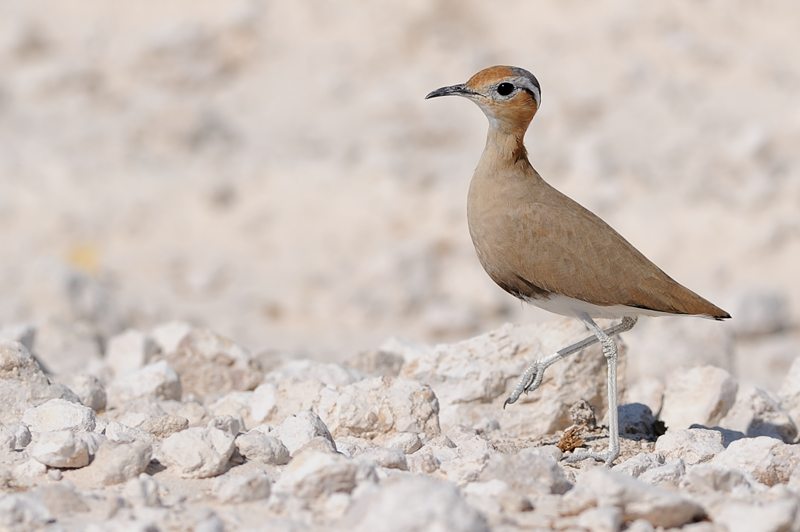 Dewi
Dewi
Etosha NP, Namibia.
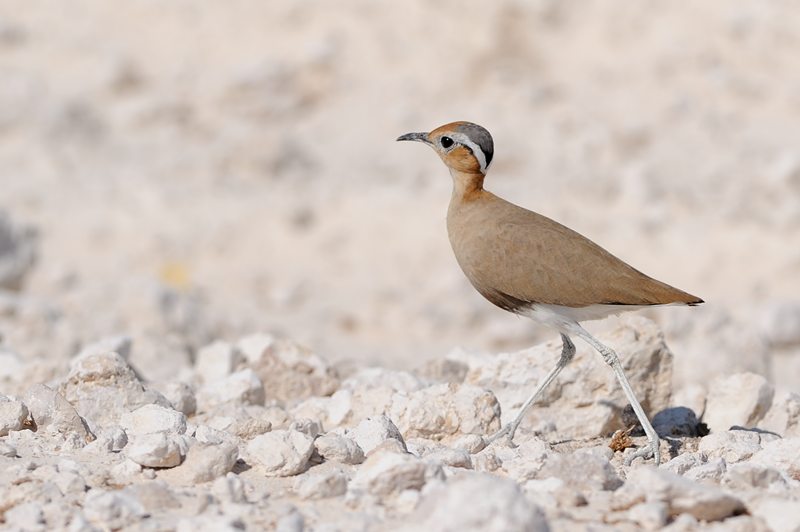 © Dewi
© Dewi
Etosha NP, Namibia.
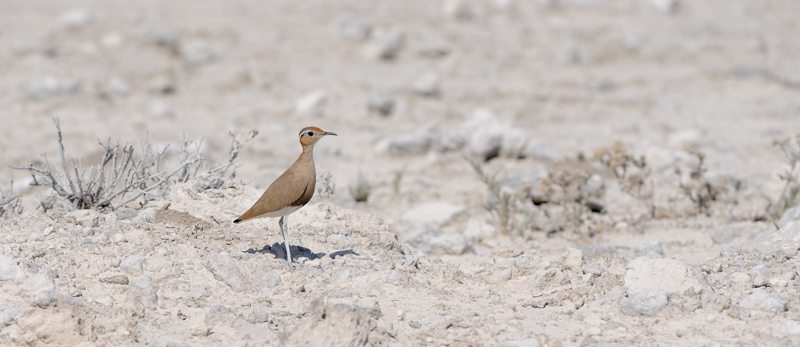 © Dewi
© Dewi
Etosha NP, Namibia.
Links:
http://www.fitzpatrick.uct.ac.za/africa ... 6(1)52.pdf
 Dewi
DewiEtosha NP, Namibia.
 © Dewi
© DewiEtosha NP, Namibia.
 © Dewi
© DewiEtosha NP, Namibia.
Links:
http://www.fitzpatrick.uct.ac.za/africa ... 6(1)52.pdf
- Flutterby
- Posts: 44150
- Joined: Sat May 19, 2012 12:28 pm
- Country: South Africa
- Location: Gauteng, South Africa
- Contact:
Temminck's Courser
300. Temminck's Courser Cursorius temminckii (Trekdrawwertjie)
Order: Charadriiformes. Family: Glareolidae
Description
Smallest African courser. Decurved, sharp bill. Rufous cap. Black and white stripes extending behind the eye. Plumage grey brown above, rufous below. Trailing flight feathers completely black. Legs white.
Differs from Burchell's Courser in being more grey-brown above, and having a rufous (not grey) hind crown and a black patch (not a bar) on the belly.
Sexes alike, juvenile is duller with lightly speckled underparts, breast pale reddish and belly blackish.
Distribution
Occupies much of sub-Saharan Africa, largely excluding the lowland forest of northern DRC and West Africa. Within southern Africa it is common in northern and central Namibia, Botswana, Zimbabwe, southern and central Mozambique and north-eastern South Africa.
Habitat
Dry, sparsely grassed and recently burned areas.
Movements and migrations
Its movements are exceedingly complex and not fully understood, however it generally moves to arid areas (such as in Botswana and Namibia) in the summer rainy season, while heading to moist areas (including the Mashonaland plateau of Zimbabwe) in the dry season, from June-December.
Diet
It mainly eats insects, doing most of its foraging by running and pausing repeatedly to pluck prey from the ground, often at the edge of a bushfire.
Breeding
Monogamous, solitary nester, performing courtship displays in which the male and female bob up and down and left to right. It does not build a nest, instead laying its eggs on flat and bare ground with good visibility. Egg-laying season is mainly in the middle to end of the dry season, from July-January. It lays 1-2 eggs, which are incubated by both sexes in shifts of about 75-120 min. The chicks are leave the nest within 7-8 hours of hatching, fed by both parents until they still start self-feeding after eight days. They are able to fly at 21 days old, fully fledging about a week later.
Call
High-pitched staccato err-err-errrr call likened to a squeaky gate.
Status
Nomadic resident. Part of population resident, some are local migrants and nomadic, and others intra-African migrants. Nowhere common but probably the commonest courser in the region. Usually in small flocks; a diurnal species.
Order: Charadriiformes. Family: Glareolidae
Description
Smallest African courser. Decurved, sharp bill. Rufous cap. Black and white stripes extending behind the eye. Plumage grey brown above, rufous below. Trailing flight feathers completely black. Legs white.
Differs from Burchell's Courser in being more grey-brown above, and having a rufous (not grey) hind crown and a black patch (not a bar) on the belly.
Sexes alike, juvenile is duller with lightly speckled underparts, breast pale reddish and belly blackish.
Distribution
Occupies much of sub-Saharan Africa, largely excluding the lowland forest of northern DRC and West Africa. Within southern Africa it is common in northern and central Namibia, Botswana, Zimbabwe, southern and central Mozambique and north-eastern South Africa.
Habitat
Dry, sparsely grassed and recently burned areas.
Movements and migrations
Its movements are exceedingly complex and not fully understood, however it generally moves to arid areas (such as in Botswana and Namibia) in the summer rainy season, while heading to moist areas (including the Mashonaland plateau of Zimbabwe) in the dry season, from June-December.
Diet
It mainly eats insects, doing most of its foraging by running and pausing repeatedly to pluck prey from the ground, often at the edge of a bushfire.
Breeding
Monogamous, solitary nester, performing courtship displays in which the male and female bob up and down and left to right. It does not build a nest, instead laying its eggs on flat and bare ground with good visibility. Egg-laying season is mainly in the middle to end of the dry season, from July-January. It lays 1-2 eggs, which are incubated by both sexes in shifts of about 75-120 min. The chicks are leave the nest within 7-8 hours of hatching, fed by both parents until they still start self-feeding after eight days. They are able to fly at 21 days old, fully fledging about a week later.
Call
High-pitched staccato err-err-errrr call likened to a squeaky gate.
Status
Nomadic resident. Part of population resident, some are local migrants and nomadic, and others intra-African migrants. Nowhere common but probably the commonest courser in the region. Usually in small flocks; a diurnal species.
- Flutterby
- Posts: 44150
- Joined: Sat May 19, 2012 12:28 pm
- Country: South Africa
- Location: Gauteng, South Africa
- Contact:
Temminck's Courser Photos
300. Temminck's Courser Cursorius temminckii
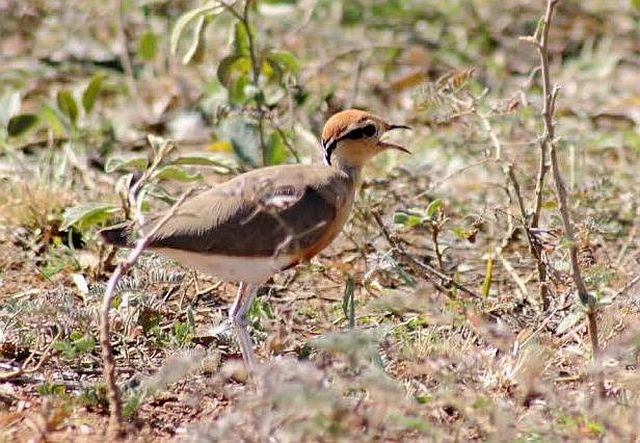
 © Pumbaa
© Pumbaa
Kruger National Park near Orpen dam
 © Guinea Pig
© Guinea Pig
Kruger National Park
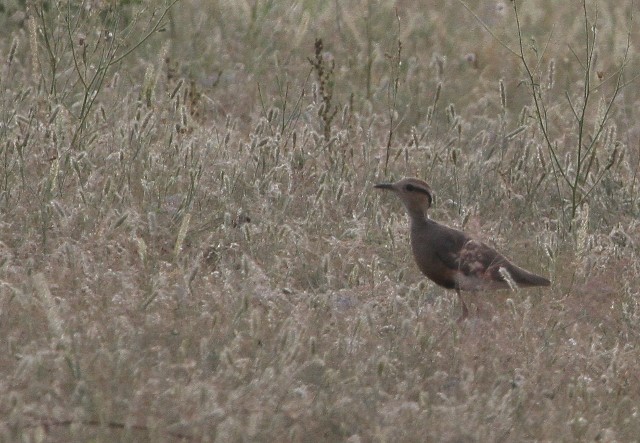 © nan
© nan
Kgalagadi Transfrontier Park, near Kieliekrankie
 © BluTun
© BluTun
Links:
Sabap2
Sasol

 © Pumbaa
© PumbaaKruger National Park near Orpen dam
 © Guinea Pig
© Guinea PigKruger National Park
 © nan
© nanKgalagadi Transfrontier Park, near Kieliekrankie
 © BluTun
© BluTunLinks:
Sabap2
Sasol
Double-banded Courser
301. Double-banded Courser Rhinoptilus africanus (Dubbelbanddrawwertjie)
Order: Charadriiformes. Family: Glareolidae
Description
Size: 25 cm. Weight: 90 g. Dark back and upperwing with pale buff feather edges and black primaries. Trailing edge of upperwing chestnut in flight. Tail has broad black terminal band contrasting with the white uppertail coverts. In flight the uppertail coverts are conspiciously white; the inner primaries and all the secundaries are chestnut. Two black chest-bands on buff underparts. Head and neck rufous, finely streaked with black with cream eyestripe. Bills are black; legs and feet greyish-white; eyes are dark brown. Males and females are alike.
Juvenile has chestnut breast bands.
Distribution
Central and Western parts of the sub-region. Occurs in two separate areas of sub-Saharan Africa, in Somalia and Ethiopia, Tanzania, Kenya and southern Africa. Within southern Africa it is locally fairly common in Namibia, Botswana, and central South Africa.
Habitat
Dry, rocky open areas, generally preferring open plains with short grass and patches of bare ground adjacent to pans, shrublands, stony or gravelly semi-desert, dry and flat riverbeds and eroded or overgrazed grassland.
Diet
Favours insects, especially ants, Northern harvester termites (Hodotermes mossambicus) and beetles (Coleoptera), doing most of its foraging by running after prey and jabbing at them its bill.
Breeding
Monogamous solitary nester, performing a courtship display in which the male dances in semi circles around the female with short hopping steps. Egg-laying season is year-round, peaking from August-December. Forms shallow scrape in ground sometimes ringed with small stones and often in amongst antilope droppings. A single rounded egg is laid directly on the ground which takes around 26 to 27 days to incubate. It is incubated by both sexes, changing shifts every 1.5-2.0 hours. The chick leave the nest within 24 hours of hatching and fledges after 5 to 6 weeks. Can have 2 or 3 broods annually.
Call
A weak, high pitched whistled peeu-weee falling and rising, and repeated kee-kee notes. Listen to Bird Call.
Status
Common Resident.
Order: Charadriiformes. Family: Glareolidae
Description
Size: 25 cm. Weight: 90 g. Dark back and upperwing with pale buff feather edges and black primaries. Trailing edge of upperwing chestnut in flight. Tail has broad black terminal band contrasting with the white uppertail coverts. In flight the uppertail coverts are conspiciously white; the inner primaries and all the secundaries are chestnut. Two black chest-bands on buff underparts. Head and neck rufous, finely streaked with black with cream eyestripe. Bills are black; legs and feet greyish-white; eyes are dark brown. Males and females are alike.
Juvenile has chestnut breast bands.
Distribution
Central and Western parts of the sub-region. Occurs in two separate areas of sub-Saharan Africa, in Somalia and Ethiopia, Tanzania, Kenya and southern Africa. Within southern Africa it is locally fairly common in Namibia, Botswana, and central South Africa.
Habitat
Dry, rocky open areas, generally preferring open plains with short grass and patches of bare ground adjacent to pans, shrublands, stony or gravelly semi-desert, dry and flat riverbeds and eroded or overgrazed grassland.
Diet
Favours insects, especially ants, Northern harvester termites (Hodotermes mossambicus) and beetles (Coleoptera), doing most of its foraging by running after prey and jabbing at them its bill.
Breeding
Monogamous solitary nester, performing a courtship display in which the male dances in semi circles around the female with short hopping steps. Egg-laying season is year-round, peaking from August-December. Forms shallow scrape in ground sometimes ringed with small stones and often in amongst antilope droppings. A single rounded egg is laid directly on the ground which takes around 26 to 27 days to incubate. It is incubated by both sexes, changing shifts every 1.5-2.0 hours. The chick leave the nest within 24 hours of hatching and fledges after 5 to 6 weeks. Can have 2 or 3 broods annually.
Call
A weak, high pitched whistled peeu-weee falling and rising, and repeated kee-kee notes. Listen to Bird Call.
Status
Common Resident.
Dewi
What is the good of having a nice house without a decent planet to put it on? (H D Thoreau)
What is the good of having a nice house without a decent planet to put it on? (H D Thoreau)
Double-banded Courser Photos
301. Double-banded Courser Rhinoptilus africanus
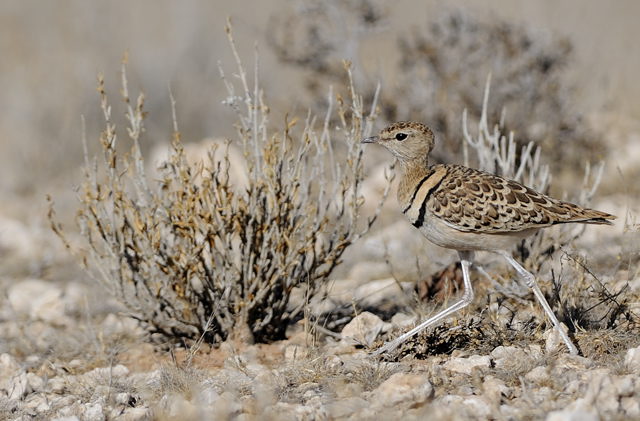
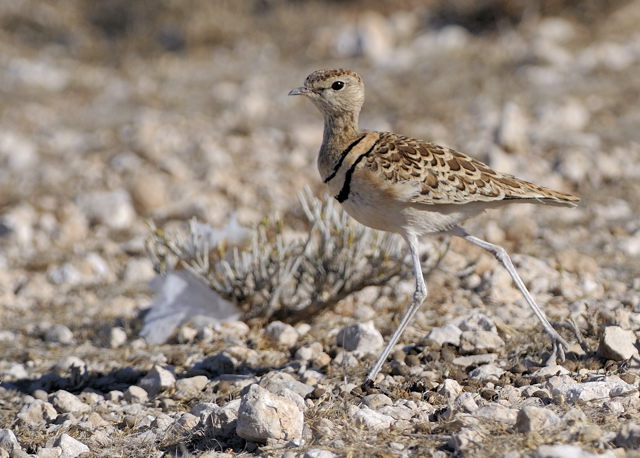 © Dewi
© Dewi

Kgalagadi Transfrontier Park. North of Langklaas, Jan 2016 © Michele Nel

Mountain Zebra National Park, August 2020 © PJL
Links:
Sabap2
Species text Sabap1

 © Dewi
© Dewi
Kgalagadi Transfrontier Park. North of Langklaas, Jan 2016 © Michele Nel
Mountain Zebra National Park, August 2020 © PJL
Links:
Sabap2
Species text Sabap1
Dewi
What is the good of having a nice house without a decent planet to put it on? (H D Thoreau)
What is the good of having a nice house without a decent planet to put it on? (H D Thoreau)
Three-banded Courser
302. Three-banded Courser Rhinoptilus cinctus (Driebanddrawwertjie)
Order: Charadriiformes. Family: Glareolidae
Description
25-28 cm. Three diagnostic bands, the upper and lower of which are rufous, ring the neck and breast. The white eye-stripe extends into a hind collar. In flight, rump is white and upper wings uniform dark brown.
Distribution
Occurs from Ethiopia and Somalia through Kenya, Tanzania, Zambia and southern Angola to southern Africa. Within southern Africa it is locally common in Zimbabwe, northern Namibia, eastern Botswana and Limpopo Province.
Habitat
It generally prefers dry, open Mopane (Colosphermum mopane) woodland, as well as miombo (Brachystegia) woodland, arid savanna and habitats with open patches created by African elephants.
Diet
Its diet has not been studied, but it probably mainly consists of insects, foraging nocturnally and often along dirt roads.
Breeding
Probably a monogamous solitary nester, digging a deep scrape in the ground beneath a bush or tree, lined with gravel, friable soil and small twigs. Egg-laying season is from April-November, peaking from August-October. It lays two eggs, which are incubated by both sexes for about 25-27 days, in shifts of roughly 90-120 minutes. The chicks leave the nest within 24 hours of hatching, remaining with their parents beyond the end of the breeding season.
Call
Spectacular call which starts with sharp keek-keek, then breaks into an accelerating rising and then falling wave of sharp kik notes.
Status
Common and resident in major river valleys of the north-east, rare and possibly nomadic elsewhere.
Order: Charadriiformes. Family: Glareolidae
Description
25-28 cm. Three diagnostic bands, the upper and lower of which are rufous, ring the neck and breast. The white eye-stripe extends into a hind collar. In flight, rump is white and upper wings uniform dark brown.
Distribution
Occurs from Ethiopia and Somalia through Kenya, Tanzania, Zambia and southern Angola to southern Africa. Within southern Africa it is locally common in Zimbabwe, northern Namibia, eastern Botswana and Limpopo Province.
Habitat
It generally prefers dry, open Mopane (Colosphermum mopane) woodland, as well as miombo (Brachystegia) woodland, arid savanna and habitats with open patches created by African elephants.
Diet
Its diet has not been studied, but it probably mainly consists of insects, foraging nocturnally and often along dirt roads.
Breeding
Probably a monogamous solitary nester, digging a deep scrape in the ground beneath a bush or tree, lined with gravel, friable soil and small twigs. Egg-laying season is from April-November, peaking from August-October. It lays two eggs, which are incubated by both sexes for about 25-27 days, in shifts of roughly 90-120 minutes. The chicks leave the nest within 24 hours of hatching, remaining with their parents beyond the end of the breeding season.
Call
Spectacular call which starts with sharp keek-keek, then breaks into an accelerating rising and then falling wave of sharp kik notes.
Status
Common and resident in major river valleys of the north-east, rare and possibly nomadic elsewhere.
Three-banded Courser Photos
302. Three-banded Courser Rhinoptilus cinctus
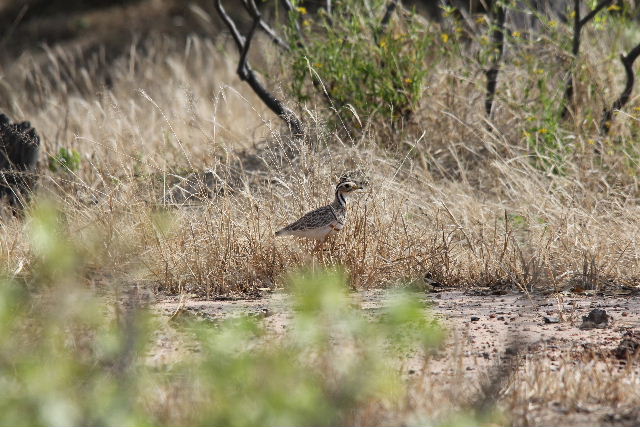 © pooky
© pooky
Zambezi Valley, Mana Pools National Park, Zimbabwe
Links:
Sabap2: http://sabap2.adu.org.za/spp_summary.ph ... §ion=3
Species text Sabap1
Birds of Botswana
Newman's Birds of Southern Africa
SASOL VOELS VAN SUIDER AFRICA (3de UIT)
 © pooky
© pookyZambezi Valley, Mana Pools National Park, Zimbabwe
Links:
Sabap2: http://sabap2.adu.org.za/spp_summary.ph ... §ion=3
Species text Sabap1
Birds of Botswana
Newman's Birds of Southern Africa
SASOL VOELS VAN SUIDER AFRICA (3de UIT)


